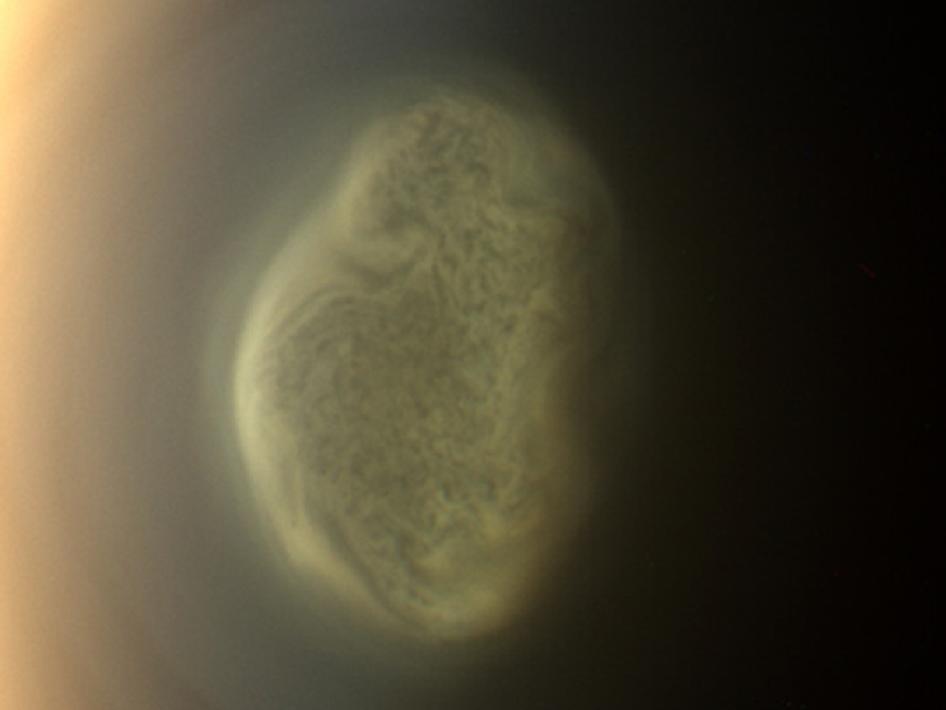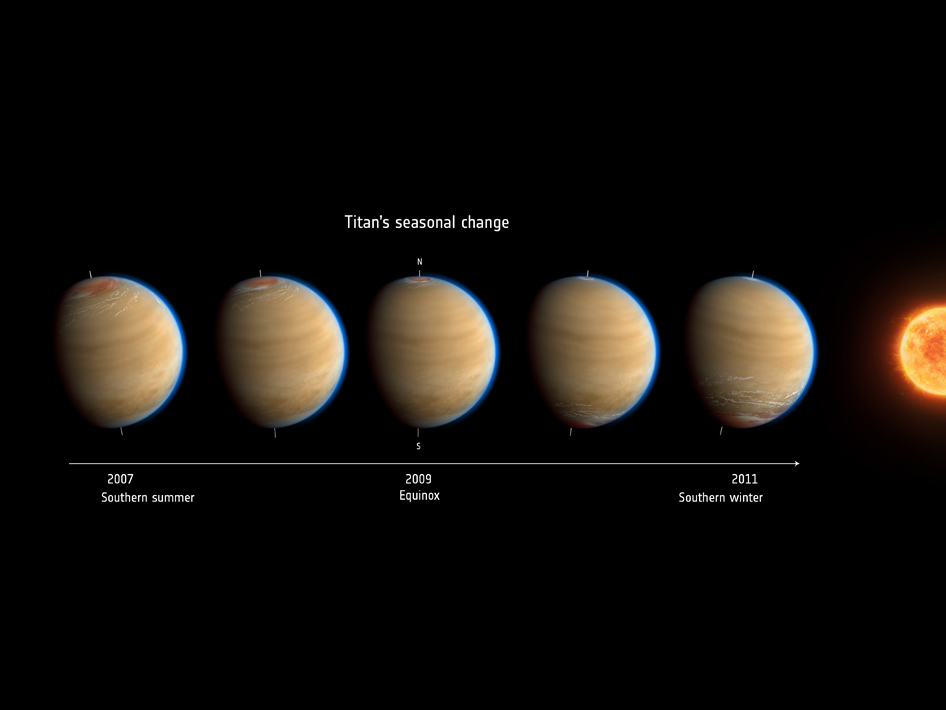NASA's Cassini spacecraft has been orbiting Saturn since 2004 so it has seen a lot - but it recently saw something that has not happened since 1997.
Seasonal atmospheric circulation direction changes on Titan, technically only a moon but bigger than the planet Mercury, happen only once every 15 years and are never observable from Earth. Titan is the only known moon to have a significant atmosphere and is one of only four terrestrial atmospheres in our Solar System - the others being Venus, Mars and obviously Earth. Since Titan's rotation axis is tilted similar to Earth, it experiences seasons in a similar way, they just take a lot longer, because Saturn takes 29.5 Earth years to orbit the Sun.
The Cassini data tie a shift in seasonal sunlight to a wholesale reversal, at unexpected altitudes, in the circulation of the atmosphere of Titan. At the south pole, the data show definitive evidence for sinking air where it was upwelling earlier in the mission. So the key to circulation in the atmosphere of Saturn's moon Titan turned out to be a certain slant of light.
The astronomers used infrared spectra measured by Cassini's Composite InfraRed Spectrometer (CIRS) instrument to determine atmospheric temperature and global distributions of chemical tracers. This allowed them to map out the seasonal changes in great detail. They observed an enormous increase in Titan's exotic trace gases over the south pole within a relatively short time. These trace gases are produced high in Titan's atmosphere, where sunlight and highly energetic particles break down nitrogen and methane and recombine to form a vast array of more complex molecules like benzene and hydrogen cyanide.

This true color image captured by NASA'S Cassini spacecraft before a distant flyby of Saturn's moon Titan on June 27, 2012, shows a south polar vortex, or a mass of swirling gas around the pole in the atmosphere of the moon. Cosmic ray hits on the camera detectors appear as bright dots in the black and white version of the image. Images taken using red, green and blue spectral filters were combined to create this natural color view. The images were obtained with the Cassini spacecraft narrow-angle camera late on June 26, 2012 at a distance of approximately 301,000 miles (484,000 kilometers) from Titan. Image scale is 2 miles (3 kilometers) per pixel. Credit: NASA/JPL-Caltech/Space Science Institute
Dr. Remco de Kok of SRON Netherlands Institute for Space Research, co-author of the new paper, said, "We were waiting for signs that the trace gas abundances would change together with the new season, but we did not expect such a large and rapid change: some gas concentrations increased more than a thousand times within only a few months. Also surprising was that this was happening at altitudes above 450 km, much higher than initially anticipated."
At these high altitudes the atmosphere goes around the planet much faster than the rotation of Titan's solid surface and can have horizontal wind speeds around the planet of up to 200m/s (450mph). Vertical winds caused by the seasonally varying hemisphere to hemisphere atmospheric circulation are much slower at a rather sluggish few millimeters per second and are hard to measure using conventional means.
Dr. Nick Teanby of the University of Bristol, lead author of the work, said, "Using measurements of temperature and chemical tracers by Cassini, we were able to observe changes in the subtle vertical winds and reveal the pole-to-pole circulation cell. For the first time ever, we observed the circulation cell direction reverse over the south pole around the time of the 2009 southern autumnal equinox. The resulting distribution of gases shows that the circulation must extend much further than previously thought to 600 km or even higher. This calls into question our current understanding of how Titan's atmosphere works and suggests new avenues to explore.
CLICK FOR LARGER SIZE. Artist's impression showing the change in observed atmospheric effects before, during and after equinox in 2009. The Titan globes also provide an impression of the detached haze layer that extends all around the moon (blue). During the first years of Cassini's exploration of the Saturnian system, Titan sported a "hood" of dense gaseous haze (white) in a vortex above its north pole, along with a high-altitude "hot spot" (red). During this time the north pole was pointed away from the sun. At equinox, both hemispheres received equal heating from the sun. Afterwards, the north pole tilted towards the sun, signaling the arrival of spring, while the southern hemisphere tilted away from the sun and moved into autumn. After equinox and until 2011, there was still a significant build up of trace gases over the north pole, even though the vortex and hot spot had almost disappeared. Similar features began developing at the south pole, which are still present today. These observations are interpreted as a large-scale reversal in the single pole-to-pole atmospheric circulation cell of Titan immediately after equinox, with an upwelling of gases in the summer hemisphere and a corresponding downwelling in the winter hemisphere. Image credit: ESA
"Our results provide a powerful new constraint for atmospheric models of Titan. Titan provides a natural laboratory for an Earth-like atmosphere in the cold outer solar system. So, these results could eventually lead to a more complete understanding of atmospheric processes on Earth, other Solar System planets, and the many exoplanetary systems now being discovered," Teanby said. "It's extremely exciting to see such rapid changes on a body that usually changes so slowly and has a 'year' that is the equivalent of nearly 30 Earth years."
"Next, we would expect to see the vortex over the south pole build up," said Mike Flasar, the CIRS principal investigator at NASA's Goddard Space Flight Center in Greenbelt, Md. "As that happens, one question is whether the south winter pole will be the identical twin of the north winter pole, or will it have a distinct personality? The most important thing is to be able to keep watching as these changes happen."
Dr. Conor Nixon at NASA Goddard Space Flight Center said, "These results are giving us the first detailed look at changes occurring in Titan's atmosphere around the time of equinox, a season which has not been viewed up close by a spacecraft previously. This shows the really great science that is coming out of the Cassini extended mission phases since 2008, and we look forward to seeing the further changes that will occur over the next five years until the end of mission in 2017."
Published in Nature






Comments